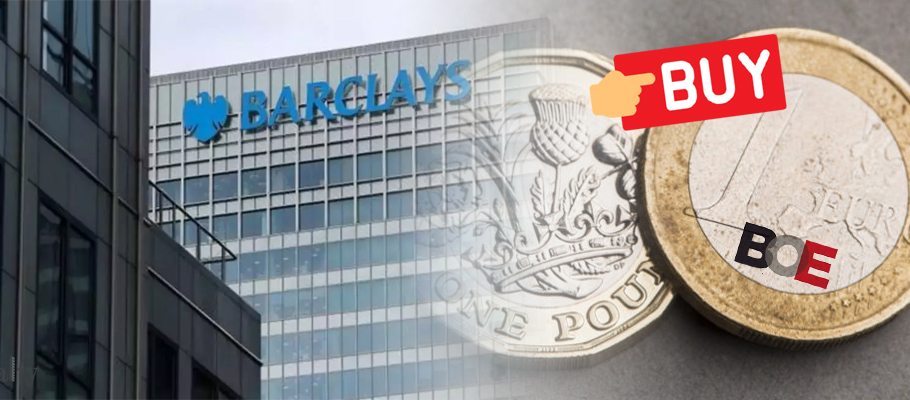
Published: January 25th, 2023
The Bank of England will deliver a surprise when it meets in February, diverging from its 2022 approach in favour of a hawkish monetary policy stance. That’s the opinion of currency strategists at Barclays, who wrote this week that the change means upside for the Pound to Euro rate over the coming weeks.
They believe a stronger UK economy and recent progress in negotiations with Brussels over the Northern Ireland protocol point to potential gains for Sterling over its continental cousin.
In a research note published on Monday 23rd January, Barclays said ‘trends in domestic inflation, strong growth, an expected hawkish turn by the (BoE) Monetary Policy Committee, plus more constructive tone from negotiations with the EU bode well for the Pound ahead of February’s bank meeting'.
The call comes after a stretch of underperformance for GBP that placed it at the bottom of the G10 major currencies list over most of December 2022.
Barclays blames the BoE for Sterling’s recent underperformance, due to raising interest rates by 50 basis points in December while warning of downside economic risks and signaling that it may need to slow the pace of interest rate rises.
Threadneedle Street regularly disappointed forex traders last year by delivering smaller-than-expected rate hikes and consistently gloomy economic forecasts.
If history is any guide, next month’s Monetary Policy Committee update (set for 2nd February) could mean losses for GBP if MPC policymakers sidestep consensus by delivering a 25-basis point rise, or issue more negative economic guidance.
Barclays does say, however, that Britain’s economy is turning out to be more resilient than the Bank believed it would in August and November, something that will be adjusted for in the next set of economic forecasts.
'Rising demand and inflation sparked a hawkish shift amongst the MPC’s core membership in December,’ said Barclays. 'That strongly suggests that February’s meeting is being underpriced by traders.’
In early November 2022 Sterling posted a strong recovery as price action suggested the Pound was being pushed up by global factors.
Analysts, however, said Britain’s domestic outlook ‘remain(ed) challenging’ and GBP’s gains might not be sustainable.
Despite those concerns the Pound was the best-performing major currency in the first week of November 2022, as global markets extended a rally from the previous week and gave the UK currency space to recover some of the losses suffered following last Bank of England meeting.
‘If risk sentiment holds then we should see modest Sterling gains through to year-end,’ wrote Barclays currency analysts in a market commentary.
Global stock markets were up in early November and stayed there at the start of this week Monday as investors bet China was preparing to end its zero-Covid policy. Economists believe such a move could give the faltering global economy a much-needed kick and provide risk-sensitive currencies like GBP a welcome nudge.
The Bank of England raised interest rates by 75 basis points on 3rd November but cautioned that rates were unlikely to go as high as the ca. 5.25 per cent investors were watching for ahead of the announcement.
Sterling made a strong start to 2022 in January and February thanks to an after-Omicron economic rebound, plus expectations at the time that the BOE was readying new interest rate hikes.
Numbers from the Office of National Statistics (ONS) showed that retail sales lifted by nearly two per cent month-on-month in January, beating consensus forecasts of one per cent and leaping ahead of December's negative four per cent reading.
In a market analysis published the week of February 21st, ING's FX Strategy Unit said that UK retail sales came back in January with a vengeance as the Omicron worries began to dissipate. 'Sterling now looks relatively less exposed than to adverse swings in geopolitical sentiment than the Euro and Nordic currencies like Swedish Krona.’
ONS data also shows commuter travel in Britain's most significant cities bouncing back to pre-Omicron levels, supporting expectations that February will be remembered as the start of a solid rebound in growth.
ING said the latest bus, train and mobility numbers also showed that offices and services in central London are now about as busy as they were before Omicron.
The figures came after Westminster announced the end of all Covid-19 related restrictions in England, even eliminating the strict testing measures that had been in place for travel, after determining that Omicron is much less deadly than earlier waves of coronavirus.
Despite positive indicators of GBP at the start of 2022, some analysts said at the time that Pound investors might be pricing in more BoE rate hikes than the bank was likely to deliver.
Forex analysts at Danske Bank wrote that while the pound may be supported by further rates action in March or May, 'the impact of hikes could be priced-out rapidly, eliminating any early mover advantage.
They said the European Central Bank (ECB) was also set to raise its key rate in September or October, 'so we believe the situation for the euro will need to be revised. Currency traders will have to adjust expectations for the pound's key rate to the downside at some stage.'
If forex traders are going to sustain high-rate hike expectations for the Pound, British inflation expectations will also have to move considerably higher.
Banker Julius Baer said in a market analysis that 'A sluggish longer-term UK growth outlook and the potential for inflation to drop back below BoE targets in two years suggest that the four rate hikes markets have priced in for this year are too optimistic. We believe a hike in May or before could happen, and maybe one additional rise in the summer. After that, we see a holding pattern from the BoE.'